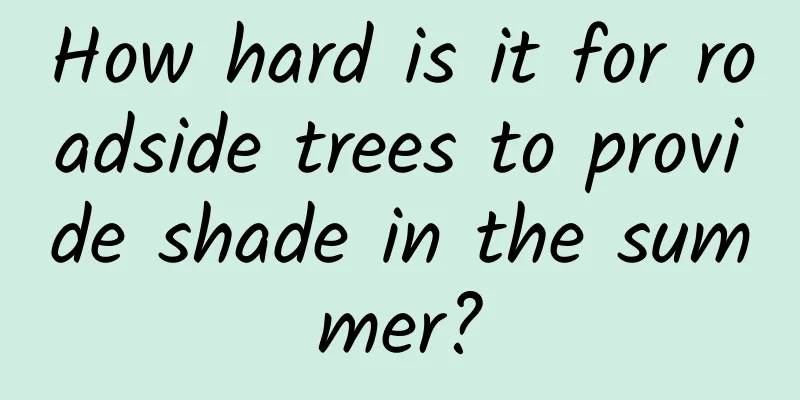How hard is it for roadside trees to provide shade in the summer?

|
Street trees provide shade in summer and are a beautiful sight in spring and autumn. However, due to problems such as flying catkins and insects, these trees receive more complaints than thanks. How difficult is it to become a qualified street tree? Written by reporter Wang Xueying Edited by Ding Lin New Media Editor/Li Yunfeng Interview experts Zhang Donglin (former deputy director of the Greening Department of Beijing Municipal Bureau of Landscape Architecture) Roadside trees are the "vanguard" who silently protect the city roads. They provide shade for pedestrians, fix carbon and release oxygen, adding a touch of natural color to the city full of "steel and concrete". From Haikou, a city with its coconut trees and sea breezes, to Hangzhou, a city with its weeping willows, different street trees create different urban landscapes. Although street trees seem to have many varieties, if we strictly classify them, the common varieties are only within a hundred or so species. Why are these varieties selected as street trees? What are the considerations for the selection and planning of urban green shade? ◇ ◇ ◇ The primary selection criteria for street tree species Unlike trees that grow in the natural environment, street trees grow in a very special environment, so they need to have strong resistance to adversity. In other words, strong survival ability is one of the important selection criteria for street trees. "Generally speaking, tall trees are used as street trees because they are taller and provide better shade," Zhang Donglin, former deputy director of the Greening Department of the Beijing Municipal Bureau of Landscape Architecture, told reporters. In order to achieve the needs of shading in summer and letting in light in winter, many northern cities will choose deciduous trees as the first choice for street trees. However, for these "big guys", the place where they "stand" is really not ideal. First, the environment for the root growth of street trees is not good. In theory, the root area of a naturally grown tree is usually about the same as the vertical projection area of the tree crown, and the root depth mainly depends on the groundwater depth, which is usually about 2 meters. In contrast, the "tree pool" that people reserve on the roadbed in advance when paving the road is usually only 1 meter square and 80 centimeters deep. The space is very small and the soil capacity is very small. Planting tall trees is almost like "standing on stepping stones." "Taking this factor into consideration, some varieties with shallow roots cannot be selected," said Zhang Donglin. "For example, Robinia pseudoacacia is a fast-growing variety with good resistance, but its roots are not deep and it is easily blown down in strong winds." ▲Street trees with shallow roots and large crowns are prone to lodging during storms, so they need to be pruned or given additional support (Photo source: Beijing Daily) Secondly, when building roads, people will repeatedly compact the ground, piling up layers of gravel, ash and even concrete, which will lead to poor water and air permeability of the roadbed medium, high alkalinity, and unfriendly to the development of tree roots. If the roots of trees growing naturally "live in a villa and have balanced nutrition for three meals a day", then the street trees growing in the tree pool live in a "tea room", not only do they have no space to stretch their limbs, but sometimes they have to face the dilemma of difficulty breathing. Sometimes, in order to pursue the beauty of green belts, people will deliberately cover the tree pool with a layer of paving decoration. If the paving material has poor air permeability, not only will the normal breathing of the roots be affected, but the effect of greening fertilization will also be greatly reduced. In addition, street trees have to endure various waste gas pollution in the city, as well as microclimates that are more severe than the natural growth environment. For example, the "heat island effect" will cause the temperature in the city center to be higher and the temperature difference between day and night to be greater, which requires trees to have better resistance to high temperatures, drought and cold. Especially in northern my country, the windy and dry environment is more likely to cause the bark to crack, giving fungi and pests more opportunities to take advantage. In short, to take root beside the city roads, it first needs tenacious vitality. If it is too "delicate", it cannot become a qualified street tree variety. ◇ ◇ ◇ In addition to being able to grow, you also need to be the president In addition to being resistant to adversities and easy to survive, street trees must also have a just-right growth rhythm. Growing too slowly or too vigorously is not an ideal situation. ▲This street tree in Dongzhimen, Beijing, has become an Internet celebrity plant because of its "just right" growth (Photo source: Qianlong.com) Providing shade and rain protection and beautifying the city are important functions of street trees, which requires that the tree canopy of street trees be large enough and maintain a long growth cycle. If the tree canopy is too small or too sparse, the shade range will not be ideal. Urban development does not leave much time for street trees to grow. If its growth rate cannot exceed the speed of urban expansion, then it loses its meaning as a street tree. For example, species such as iron birch and fir, although the trees are tall and have a long lifespan, the trunks of these species may not be as thick as a bowl after hundreds of years, and are obviously not suitable as street trees. Street trees must also be resistant to pruning. It is good to have trees with lush branches and leaves in the wild, but in cities, overly lush street trees may affect road signs and traffic lights, or affect the lighting of residential buildings, so they also need to be pruned frequently. However, unlike the meticulous cultivation in the garden, the pursuit of efficiency in greening work cannot "carve" every tree, and sometimes even "shaved head" violent pruning may occur. Therefore, if the tree cannot resume growth quickly after pruning, it is easy to "die" halfway. ▲When trees affect lighting, ventilation or pose a safety hazard, they will be pruned back (Photo credit: Shanghai Greening and Urban Appearance Administration) In addition to being able to grow, street trees must also know how to grow. If the annual growth period is short and the trees are dormant for most of the year, they will not be able to decorate the city. Many years ago, someone proposed to use a variety of ash trees in Beijing as street trees. "When ash trees bloom, they are very beautiful, but there is a problem that they shed their leaves too early, and they are not beautiful when they are dormant." Zhang Donglin told reporters. In addition, if the trunk is not straight and regular enough, and the posture is too "enchanting", it will affect traffic lights and traffic; in order to avoid the problem of "short neck", the trunk of the street tree must be forked at least two meters above, otherwise it will block the road and it will not work even if it is trimmed. In addition, the easy falling of leaves and fruits sometimes increases the maintenance cost of roadside trees. Imagine that you are walking under a shady tree on a hot summer day, and suddenly a jackfruit falls from the sky... The fruit drop crisis exists in street trees across the country: in Beijing, persimmon trees are full of bright yellow persimmons in autumn and winter, but to naive pedestrians, they may fall with the wind at any time and become a "yellow bomb"; in Xiamen, old trees on both sides of the street are full of bunches of mangoes, which makes the city streets unique, but after every storm, cleaning up the scattered fruit residues on the ground has become a headache for sanitation workers. In addition to fallen fruits, some varieties of fallen leaves can also cause danger. In May this year, a pedestrian was knocked unconscious by a fallen leaf on the street in Foshan, Guangdong. However, the "real culprit" that hit him was not an ordinary leaf, but a nearly 3-meter-long royal coconut leaf. (Photo source: Qilu.com) As a common street tree species in tropical areas, the royal coconut is the tallest and most spectacular coconut plant among domestic street trees and landscape trees. The tree is usually 10-20 meters tall, and one leaf is 3-5 meters long. ◇ ◇ ◇ Beijing’s roadside trees: native or introduced? As a common tree species for urban greening, Sophora japonica is not only cold-resistant, drought-resistant, and pruning-resistant, but also highly resistant to pollution, and therefore has a long history of planting in Beijing. According to incomplete statistics, there are more than 500,000 Sophora japonica trees in the urban area of Beijing alone. What few people know is that Sophora japonica was almost banned due to rampant insect pests - in addition to falling leaves and fruits, "fallen insects" are also an annoying demerit for roadside trees. It turns out that although the Chinese Sophora japonica is tough, it is very vulnerable to the Sophora japonica looper. This moth is known as the "hanged ghost" in its larval stage. It will hang down from the tree with a thread, which not only affects pedestrians and hinders the beauty of greening, but can also move quickly to other trees with the help of wind. If not dealt with in time, it will seriously affect the health of surrounding trees. In recent years, with the development of biological control and tree spraying technology, the Sophora japonica looper crisis has been curbed to a certain extent. ▲The Chinese Sophora japonica bears witness to the long history of the ancient capital. Among the deciduous trees in Beijing, the ancient Sophora japonica has the largest number of trees over 100 years old. In 1986, the Chinese Sophora japonica and Platycladus orientalis were selected as the city's city tree. The picture shows the ancient Sophora japonica "Tang Sophora japonica" in Beihai Park, which has a history of more than 1,200 years (Photo source: Beijing Daily) "Pests are very troublesome. As a native tree species, elms were planted a lot in Beijing, but due to the high incidence of pests, they were gradually abandoned." Zhang Donglin told reporters that both elm seeds and elm bark contain a lot of starch, which makes them very easy to attract insects. In addition, elms are also prone to diseases, such as Dutch disease caused by fungi. Because the prevention and control technology in the 1970s was very limited, elm trees eventually became increasingly rare in Beijing. "Not only elm trees, but also paulownia trees, which were very popular in the past few years, bloom every spring and the flowers are very large, which is indeed very beautiful, but they are also prone to witches' broom disease, which is very difficult to treat. There are many problems with large-scale planting," Zhang Donglin explained. Compared with the elms and locust trees mentioned above, poplars and willows are more "hardy", especially poplars, which played a huge role in Beijing's greening projects in the last century. At the beginning of the founding of New China, Beijing tried to plant Populus edulis and Populus canadensis, but later replaced them with Populus tomentosa and Populus rapae cultivated in Yi County, Hebei Province due to serious moth damage. As a native tree in Beijing, poplars have strong adaptability, few diseases and insect pests, grow quickly, and have beautiful tree shapes. They have played a huge role in the greening of the capital and the alleviation of sandstorms. However, at that time, people chose to plant female poplars with larger crowns, ignoring the problem of female poplars' flying catkins. In recent years, there have been increasing calls in society to "replace female poplars with male poplars." But in Zhang Donglin's opinion, it is not appropriate to hope to eliminate the catkin damage by "replacing female poplars with male poplars": "Compared with female poplars' flying catkins, male poplars' pollen actually has a greater impact on people." ▲The female inflorescence (left) and male inflorescence of Populus tomentosa (Photo source: "Forestry Beijing" WeChat account) In order to enhance the humanistic characteristics of cities, many cities have begun to innovate in greening in recent years, planting many new street trees, such as Beijing's sycamore and American red maple. However, there are still many questions behind the beautiful new landscapes - are they suitable for Beijing? Take the plane tree as an example: the common plane trees in China can be divided into one-ball plane tree (American sycamore), two-ball plane tree (British sycamore) and three-ball plane tree (French sycamore) according to the amount of fruit. "According to climatic conditions, Beijing is more suitable for planting cold-resistant American sycamore. British sycamore is not so frost-resistant and is particularly picky about the environment. The same batch of plane trees planted on different streets in Beijing may survive on one side of the street in one winter, while those on the other side are frozen to death... For urban greening, unified management is too difficult." Zhang Donglin told reporters. At present, few people on the market have made subdivisions for plane tree seedlings, which may lead to "stepping on mines" in the seedling selection stage of urban greening. Careful citizens may find that in recent years, many maple trees have appeared in Tongzhou and near the Madian Interchange, creating a fiery red scene in autumn. "American red maple is indeed beautiful and stylish, but from the perspective of soil conditions, it is not so suitable for Beijing, especially in Tongzhou, where there is heavy salinity. It may survive for a few years, but it will definitely not grow well over time." In Zhang Donglin's view, urban greening should adhere to the principle of "suitable trees for suitable places", maintain a scientific and rational attitude in the process of seeking innovation, and consider the long-term perspective when introducing new varieties, while also being more tolerant of native tree species. |||| Produced by: Science Central Kitchen Produced by: Beijing Science and Technology News | Beijing Science and Technology Media Welcome to share to your circle of friends Reproduction without authorization is prohibited |
<<: Why is the silver bracelet ineffective in testing poison?
>>: After being hit 5 times in half a year, can the Webb telescope still work normally?
Recommend
The romantic science and engineering man builds a satellite into space to capture the love flower of the universe
Do you like the silly Sheldon, or Howard who want...
WeChat ID can be changed at will? Official: It's just a bug
Recently, there have been a lot of news about WeC...
Policies support the pickup truck industry and 2019 is expected to be a year of market explosion
The past 2018 was a memorable year for everyone w...
TikTok anchor PK strategy and skills
5 Tips for Hosts to Connect with MCs 16 game cont...
Is it true that old users of Pinduoduo become new users? How can I withdraw the 100 yuan I got for free from Pinduoduo quickly?
Pinduoduo's activity of getting 100 yuan for ...
How does Baidu bidding respond to the reduction in promotional spaces?
Introduction Recently, some changes have taken pl...
"This time, Chinese astronauts may plant several crops of rice in space"
From the successful launch on the afternoon of Ju...
Windows 10 update infinite "initialization": the solution is here
Microsoft has just pushed out the Windows 10 Buil...
The Wisdom of Not Getting Sick 2: Qu Limin Explains the Twelve Meridians and the Eight Extraordinary Meridians
The Wisdom of Not Getting Sick 2: Qu Limin's ...
How many ants are there on Earth? Scientists have finally counted them!
Ants are a common insect, but how many ants are t...
Why now isn't the best time to buy a Moto 360
When Google officially launched the Android Wear ...
Analysis of marketing promotion hot spots in September!
September is the start of the school year, and th...
TSMC: 4Q20 revenue reached US$12.68 billion, up 22% year-on-year
On January 14, 2020, TSMC, the leading wafer foun...
After the age of 40, is it really the end of the road for programmers?
Is ageism a career problem in software developmen...









